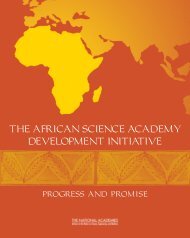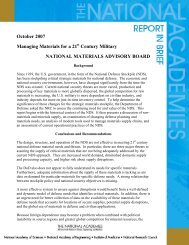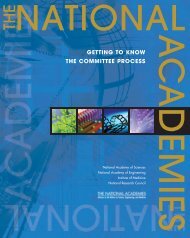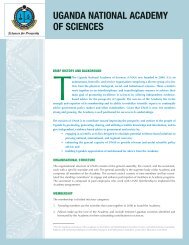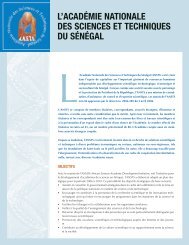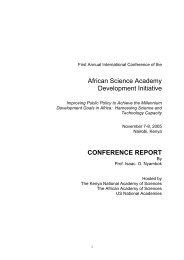Report to Congress 2011 - National Academies
Report to Congress 2011 - National Academies
Report to Congress 2011 - National Academies
You also want an ePaper? Increase the reach of your titles
YUMPU automatically turns print PDFs into web optimized ePapers that Google loves.
A Message From the Presidents<br />
The year <strong>2011</strong> was one of the 10 warmest in the modern meteorological record, making the release of<br />
the final report of our America’s Climate Choices series particularly timely. These ambitious studies by the<br />
<strong>National</strong> Research Council were aimed at ensuring that the nation’s climate decisions are informed by the<br />
best possible scientific knowledge, analysis, and advice. The final report reiterated the call for an urgent,<br />
coordinated national response <strong>to</strong> climate change, with substantial reductions in greenhouse gas emissions<br />
among the highest priorities, and a plan for reducing vulnerability <strong>to</strong> global warming’s inevitable impacts.<br />
Reducing risk was also a primary focus of the <strong>National</strong> Academy of Engineering and <strong>National</strong> Research<br />
Council’s final report on the Deepwater Horizon explosion. The report urged the offshore drilling industry<br />
and government regula<strong>to</strong>rs <strong>to</strong> take a “systems safety” approach <strong>to</strong> drilling operations, anticipating and<br />
managing dangers at every level of an inherently risky endeavor.<br />
Health care continued <strong>to</strong> be a major issue in <strong>2011</strong>. Under the Patient Protection and Affordable Care Act,<br />
participating insurance plans are required <strong>to</strong> cover a set of preventive, diagnostic, and therapeutic services<br />
that have been defined as “essential.” A report from the Institute of Medicine offered a set of criteria<br />
and methods <strong>to</strong> develop a package of benefits <strong>to</strong> cover many important health care needs and still be<br />
affordable.<br />
This <strong>Report</strong> <strong>to</strong> <strong>Congress</strong> summarizes these and 17 others from the nearly 450 studies and projects<br />
completed by our <strong>Academies</strong> in <strong>2011</strong>. And beginning this year, anyone with access <strong>to</strong> the Internet can<br />
download our reports free of charge. This fulfills our long-held goal of making our work freely accessible<br />
around the world.<br />
In <strong>2011</strong>, E. William (Bill) Colglazier, who served our institution as executive officer for 17 years, stepped<br />
down from the <strong>National</strong> Academy of Sciences and <strong>National</strong> Research Council and was promptly appointed<br />
science and technology adviser <strong>to</strong> the U.S. Secretary of State. Bill’s new position, we are pleased <strong>to</strong> note,<br />
was established in response <strong>to</strong> our 1999 report on the role science, technology, and health can play<br />
in international diplomacy. In 2012, Bruce B. Darling joins us from University of California as our new<br />
executive officer. Bruce brings extensive experience <strong>to</strong> the post, most recently as UC’s vice president of<br />
labora<strong>to</strong>ry management for the Department of Energy labora<strong>to</strong>ries at Los Alamos, Livermore, and Berkeley.<br />
RALPH J. CICERONE CHARLES M. VEST HARVEY V. FINEBERG<br />
President President President<br />
<strong>National</strong> Academy of Sciences <strong>National</strong> Academy of Engineering Institute of Medicine<br />
Chair<br />
Vice Chair<br />
<strong>National</strong> Research Council<br />
<strong>National</strong> Research Council




